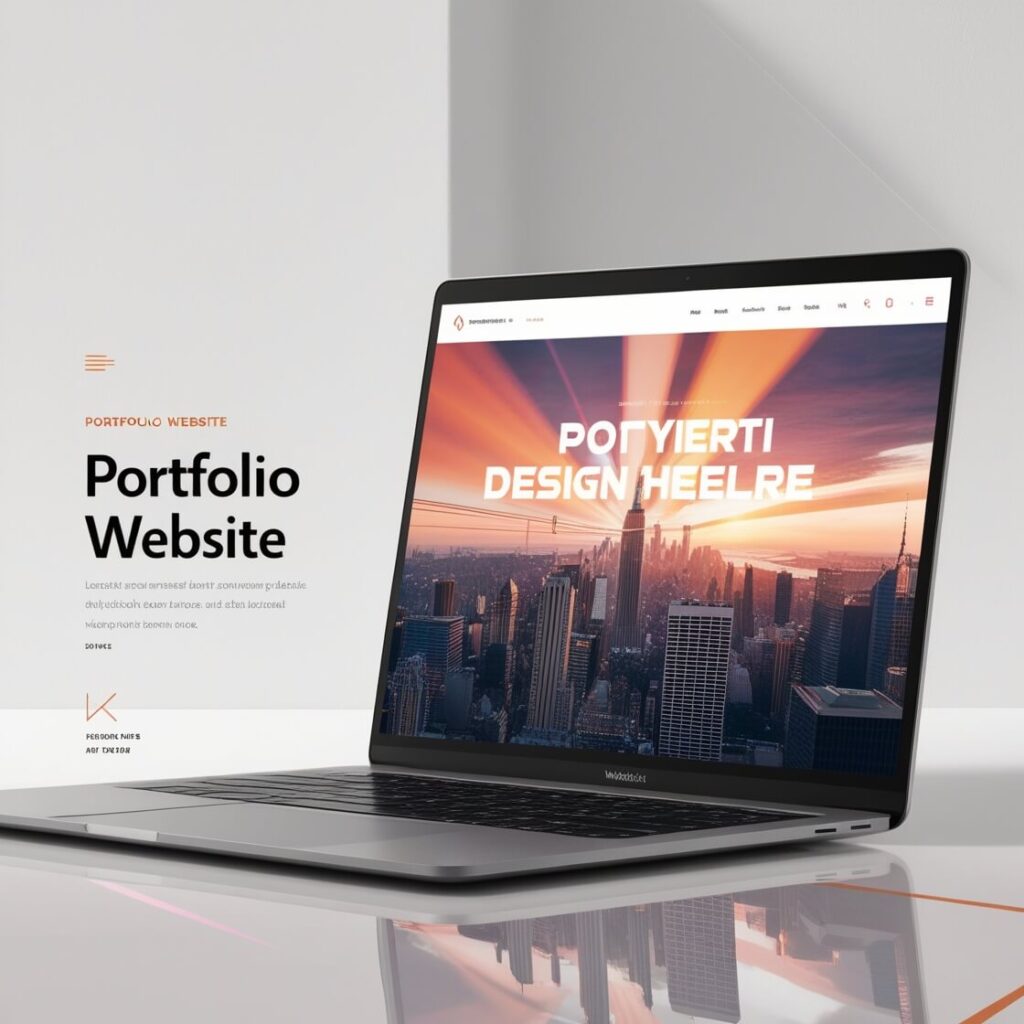Introduction
In today’s digital world, a well-crafted portfolio website is more than just a showcase of your work—it’s your personal brand’s first impression. Whether you’re a designer, developer, photographer, or freelancer, your portfolio serves as a powerful marketing tool that can attract clients, employers, and collaborators. But how do you design a portfolio that stands out from the crowd?
Creating a stunning portfolio website goes beyond just uploading your best projects. It’s about curating an online experience that reflects your skills, personality, and attention to detail. From choosing the right platform to focusing on design elements that improve user experience, every aspect of your portfolio plays a role in making that memorable impact. In this guide, we’ll walk you through the essential steps and best practices for creating a portfolio website that not only looks great but also helps you land your next big opportunity.
Why Portfolio Website Design Matters
Your portfolio website is often the first interaction potential clients, employers, or collaborators will have with your work. Whether you’re a graphic designer, web developer, photographer, or any other creative professional, your portfolio acts as both a showcase and a reflection of your skills. It’s not just about displaying your projects; it’s about conveying your professional identity and the quality of your work through design. Here’s why the design of your portfolio website is so crucial:
The Role of a Portfolio Website in Your Career
In an age where everything is online, your portfolio website is essentially your digital resume. It’s often one of the first things people will check when considering you for a project or job. A portfolio that is visually appealing and easy to navigate speaks volumes about your attention to detail and professionalism. A well-organized website can demonstrate that you’re not just talented but also understand the importance of good design, user experience, and even SEO. Your portfolio should convey that you have the skillset to not only execute creative projects but to also manage your own brand effectively.
Portfolio Websites as a Personal Branding Tool
Your portfolio is a direct representation of who you are as a professional. How it’s designed—whether it’s sleek and modern or creative and eclectic—reflects your personality and design style. It’s more than just a collection of projects; it’s an opportunity to communicate your unique value proposition. Through colors, fonts, layout, and navigation, your portfolio website tells a story about you before someone even sees your work. Your branding, from your logo to the tone of voice on your site, should align with the type of clients or employers you’re targeting. If your website design is inconsistent or hard to navigate, it could send the wrong message to visitors about your capabilities and expertise.
The Impact of First Impressions
When visitors land on your portfolio website, you have mere seconds to capture their attention. Research shows that users tend to judge a website’s credibility within the first few seconds of viewing it. If your portfolio isn’t designed well, they might leave before even exploring your work. A stunning design not only grabs attention but also sets the tone for a positive user experience. This includes smooth navigation, quick load times, clear typography, and an overall visual flow that guides visitors effortlessly through your projects. The first impression is crucial; a poorly designed portfolio could mean missed opportunities. On the flip side, a visually engaging and easy-to-navigate portfolio will make visitors more likely to stay longer and dive deeper into your content.
Key Elements of a Stunning Portfolio Website Design
Creating a portfolio website that stands out requires more than just showcasing your best work. It’s about crafting an experience that leaves a lasting impression on your visitors while highlighting your skills in a way that’s easy to navigate and visually appealing. Let’s dive into the key elements that make a portfolio website truly stunning.
Clear and Simple Navigation
One of the most important aspects of a great portfolio website is navigation. If visitors can’t find what they’re looking for quickly and easily, they’re likely to leave your site and go elsewhere. The key here is simplicity and clarity.
- Logical Structure: Your website’s menu should clearly define sections like “Home,” “About,” “Portfolio,” “Blog,” and “Contact.”
- Sticky Menus and Links: Using a sticky navigation bar that stays at the top of the page as users scroll is an effective way to keep your navigation always visible.
- Clear Call-to-Actions (CTAs): Make sure that the next step you want visitors to take (such as “Contact Me” or “View My Work”) is easy to spot. Using distinct buttons or links can help guide users through their journey on your site.
The simpler and more intuitive your navigation, the better user experience you’ll provide, allowing visitors to focus on your content rather than searching for it.
Eye-Catching Visuals and Interactive Features
As a creative professional, your portfolio should be visually engaging. It’s essential to use eye-catching visuals that showcase the quality of your work and reflect your unique style. However, the design should complement, not overshadow, your work. The focus should always be on the projects you’re presenting.
- High-Quality Images and Videos: Ensure that all visuals, including photographs, graphics, or videos, are high resolution. Poor-quality images can make your work look less professional and turn potential clients or employers away.
- Interactive Elements: Adding interactive features such as hover effects, animations, or scroll-triggered animations can make the browsing experience more engaging. Interactive elements can add personality and make the site feel more dynamic. However, it’s important not to overdo it—use these elements sparingly to avoid overwhelming the user.
Including a well-thought-out design that reflects your style through visuals and interaction can set your portfolio apart from others.
Showcasing Your Work Effectively
The central goal of your portfolio is to highlight your skills and projects. How you present this work is just as important as the work itself. A stunning portfolio will feature your projects in a way that tells a compelling story.
- High-Impact Project Thumbnails: Use thumbnails that grab attention. The first impression is often made based on the visual appeal of these project previews. They should be clear, sharp, and easy to view.
- Detailed Case Studies: Don’t just display your work—tell its story. Include brief but informative case studies for each project that explain your process, the challenges you faced, and the results you achieved.
- Categorize Projects: If you have a wide range of work (e.g., branding, web design, photography), it’s useful to categorize your projects. This makes it easier for visitors to explore specific types of work they’re interested in, such as “Web Design,” “Graphic Design,” or “UI/UX Projects.”
By showcasing your work effectively, you not only display your skills but also communicate your thought process and creativity, which can be a huge selling point for clients or employers.
Mobile-Friendly and Responsive Design
In today’s mobile-first world, it’s essential that your portfolio website looks just as good on smartphones and tablets as it does on desktop computers. Mobile traffic is increasing, and you can’t afford to lose potential clients because your website doesn’t render well on smaller screens.
- Responsive Layouts: Ensure that your website adapts smoothly to different screen sizes. Elements such as images, text, and navigation should adjust to the device in use.
- Touch-Friendly Navigation: Make sure that navigation is optimized for touch interfaces, meaning buttons should be easy to click on small screens and interactive elements should be mobile-friendly.
A responsive and mobile-optimized design isn’t just a luxury—it’s a necessity for providing a top-notch user experience.
Portfolio Website Design Best Practices
Designing a stunning portfolio website goes beyond picking the right platform or template. To truly make your website stand out and provide the best experience for your visitors, there are several best practices you should follow. These practices ensure that your portfolio is not only visually appealing but also functional, professional, and easy to navigate. Let’s explore the key best practices that every portfolio website should consider:
Embrace Visual Storytelling
Visual storytelling is one of the most powerful tools at your disposal. Instead of simply presenting your work as static images or lists of projects, think of your portfolio as a narrative that guides your visitors through your creative journey.
- Tell the Story Behind Each Project: Include brief explanations of your projects to help visitors understand the context and your role. Explain the problem you were solving, your process, and the outcomes. This adds depth to your work and shows potential clients or employers how you think, create, and deliver solutions.
- Use Engaging Visuals: Incorporate engaging visuals like mood boards, sketches, wireframes, or videos that showcase the evolution of your work. This can help create a story that’s more immersive and memorable.
- Create a Cohesive Visual Theme: Make sure the visual elements of your website—colors, fonts, and layout—align with the story you’re telling. A cohesive visual theme across the website reinforces your personal brand and the narrative you want to convey.
Visual storytelling helps humanize your work, making it more relatable and impactful for your audience.
Focus on the User’s Journey
The user experience (UX) is one of the most important aspects of your portfolio website design. After all, visitors should have an enjoyable and seamless experience as they explore your work. The user’s journey refers to how visitors navigate your website and interact with your content, and optimizing this journey is key to creating a successful portfolio.
- Simplify the Navigation: A clear and easy-to-understand navigation structure will guide visitors through your portfolio with ease. Make sure your most important sections, such as your portfolio, about you, and contact information, are easily accessible.
- Prioritize Accessibility: Your website should be accessible to all users, including those with disabilities. Consider using legible fonts, providing alt text for images, and ensuring there’s enough contrast between text and background for readability. Accessibility not only helps more people access your content but also enhances the overall user experience.
- Keep Load Times Fast: Slow websites frustrate visitors and can lead them to leave before seeing your work. Optimize your website’s performance by compressing images and using efficient coding practices. Fast load times are crucial for keeping visitors engaged.
A smooth and intuitive user experience ensures that visitors can focus on your work, not on figuring out how to navigate your website.
Keep It Updated and Fresh
Your portfolio website should be a living, breathing representation of your current skills and work. Keeping your website fresh and up-to-date is essential for ensuring that it remains relevant and accurately reflects your professional growth.
- Regularly Add New Projects: Make it a habit to add new work as you complete it. This will not only keep your portfolio looking current but also show potential clients or employers that you’re actively working and growing in your field.
- Remove Outdated Work: As you improve and develop new skills, some of your older work may no longer reflect your current abilities. Regularly review your portfolio and remove projects that are no longer aligned with your personal brand or the direction you’re headed in your career.
- Update Your Bio and Contact Information: As your career evolves, so should your bio and contact information. Update these sections regularly to reflect your latest accomplishments and provide visitors with the best ways to reach you.
An up-to-date portfolio shows that you’re committed to your profession and that you’re actively working to refine your skills and deliver exceptional results.
Incorporate Testimonials and Case Studies
When designing your portfolio, it’s not just about displaying your work—it’s also about building trust with your audience. Testimonials and case studies can help you establish credibility and prove the value you bring to your clients or employers.
- Include Client Testimonials: Positive feedback from clients or colleagues can go a long way in building trust with new visitors. Display testimonials that speak to your professionalism, skills, and ability to deliver results.
- Showcase Detailed Case Studies: Instead of just showing a finished product, provide insights into your process. Include detailed case studies that outline the problem, your approach, the solution, and the outcome. This gives potential clients a deeper understanding of how you work and what they can expect from you.
- Highlight Specific Results: Whenever possible, provide quantifiable results (such as increased website traffic, improved sales, etc.) to demonstrate the impact of your work. This can strengthen your credibility and make your portfolio even more compelling.
Testimonials and case studies not only help build trust but also give potential clients insight into how you approach projects and deliver results.
Conclusion
Creating a stunning portfolio website is an essential step in building your personal brand and showcasing your professional skills. It’s not just about displaying your work—it’s about telling a story, creating a seamless user experience, and ensuring that visitors are left with a lasting impression of your capabilities.
By focusing on key elements like clear navigation, eye-catching visuals, and mobile-friendly design, you can ensure that your portfolio is both functional and visually engaging. Additionally, incorporating best practices such as embracing visual storytelling, keeping your content up-to-date, and highlighting testimonials and case studies will help build trust and credibility with potential clients and employers.
Remember, your portfolio website is often your first opportunity to make an impact. Whether you’re just starting out or looking to refresh an existing site, following these tips will help you create a portfolio that stands out, reflects your unique style, and drives your career forward. So, take the time to design a website that you’re proud of—it’s an investment that will pay off in attracting the right opportunities and clients.



